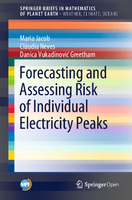Forecasting and Assessing Risk of Individual Electricity Peaks
Author(s)
Jacob, Maria
Neves, Cláudia
Vukadinović Greetham, Danica
Language
EnglishAbstract
The overarching aim of this open access book is to present self-contained theory and algorithms for investigation and prediction of electric demand peaks. A cross-section of popular demand forecasting algorithms from statistics, machine learning and mathematics is presented, followed by extreme value theory techniques with examples. In order to achieve carbon targets, good forecasts of peaks are essential. For instance, shifting demand or charging battery depends on correct demand predictions in time. Majority of forecasting algorithms historically were focused on average load prediction. In order to model the peaks, methods from extreme value theory are applied. This allows us to study extremes without making any assumption on the central parts of demand distribution and to predict beyond the range of available data. While applied on individual loads, the techniques described in this book can be extended naturally to substations, or to commercial settings. Extreme value theory techniques presented can be also used across other disciplines, for example for predicting heavy rainfalls, wind speed, solar radiation and extreme weather events. The book is intended for students, academics, engineers and professionals that are interested in short term load prediction, energy data analytics, battery control, demand side response and data science in general.
Keywords
Mathematics; Mathematics; Statistics ; Energy efficiency; Algorithms; Energy systemsDOI
10.1007/978-3-030-28669-9Publisher
Springer NaturePublisher website
https://www.springernature.com/gp/products/booksPublication date and place
Cham, 2020Series
Mathematics of Planet Earth,Classification
Numerical analysis
Probability and statistics
Applied mathematics
Energy technology and engineering


 Download
Download Web Shop
Web Shop